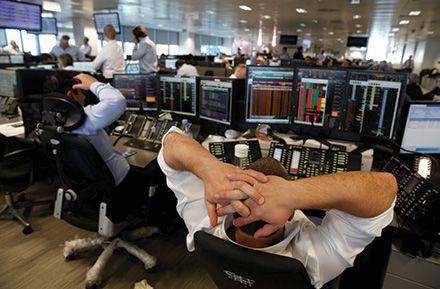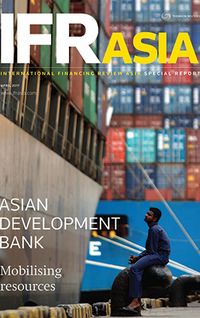Asia has benefited from a relatively benign global backdrop in recent years, and is on track to grow at close to 6% again in 2017. Global risks, however, are rising after the UK’s decision to exit the European Union and the arrival of a new US administration.
Fears of a hard landing for China’s economy are no longer investors’ biggest concern for Asia. Instead, they have given way to something potentially far more serious.
A series of elections and referenda in Europe is making the European Union look increasingly fragile, following the UK’s shock decision to exit last year. Donald Trump’s new US administration is battling opposition to its policies on immigration and healthcare, questioning whether the President will be able to the deliver on his pro-growth promises. And geopolitical tensions are rising as a result of US missile strikes in Syria and weapons tests in North Korea.
Global shocks are, by definition, impossible to foresee, but the uncertainty that comes with growing global tensions can have a paralysing effect on investment. Many Asian countries were hit by heavy capital outflows when the US Federal Reserve said it would begin tapering its quantitative easing programme in 2013, and the region may again find itself caught in the crossfire if global investors call in their chips once more.
“A lot of the risks come from policy uncertainty,” said Joseph Zveglich, director of macroeconomic research at the ADB. “Whereas two years ago you could count on at least a thinking that more trade and freer trade was largely beneficial … that philosophy can no longer be taken for granted.”
Economists believe Asia is fundamentally sound, and can take comfort from the latest Chinese GDP data showing annual growth accelerating to 6.9% in the first quarter of 2017.
The ADB expects developing Asia to grow 5.7% this year and in 2018, down only a fraction from 5.8% in 2016, but notes that global financial risks will be a key theme this year.
“The risks to Asia are external,” said Juzhong Zhuang, deputy chief economist. “The Fed’s move is largely factored in, but there is a risk that rates could rise faster than expected.”
European disunion
The future of the European Union is among the biggest concerns facing global investors and policymakers. At the time of writing, anti-establishment candidates were not expected to win the French presidential elections, but markets have learned not to trust predictions following the UK’s Brexit vote last June.
After the French vote, attention will shift to Germany, where Chancellor Angela Merkel is also standing for re-election in September.
Nicolas Sarkozy, the former French president, describes Brexit as a “mistake for everyone” and warns that the continent is heading for an existential crisis over the next few years.
“The worst is yet to come,” he said at a Credit Suisse conference in Hong Kong in March. “There’s only one way to fix this (…) The Europeans need to be smart enough to recognise that the European model has to be rebuilt. They need to come up with a new treaty with new powers. And that way the British can vote again, but on a new treaty.”
“In Europe we’re looking at some complex, troubled times. And out of that period we will see a new European model. I am convinced we will see a new Europe, and none of us can afford to stand still.”
Zhuang does not see turmoil in Europe as a near-term risk, but concedes that the medium-term outlook is clouded.
“Looking at a forecasting horizon of this year and next year, there is uncertainty, but the impact will not be that great,” he said. “That sort of thing probably will not be immediate. Of course we hope that nothing will change in a significant way in terms of trade, policy and investment.”
Still, Japanese data showed investors reduced their holdings of French sovereign bonds in the run-up to the French elections.
According to the European Central Bank’s latest economic bulletin, released in March, non-euro area investors were net sellers of euro area debt securities in 2016 for the first time since the inception of the currency.
Zveglich argues that spillovers from Europe would be “relatively small”.
“When European banks were retrenching around the time of the Greek debt crisis, a lot of regional and US banks took up the slack,” he said. “If we were to see a sharp downturn in Europe it would be felt in Asia, but it’s not the same as a turndown in the US.”
The EU accounts for about 15% of Asian trade volumes, and the UK about 2%–3%. While some Asian exporters may look to direct negotiations with the UK as an opportunity, Zveglich does not see an immediate benefit. Commonwealth nations such as India and Australia may be able to win preferential terms, he says, but bilateral negotiations will take years.
“First things first,” he said. “If there is a relatively amicable divorce from the EU… and once outside the UK parliament starts to think about what changes to legislation it might make, then that really opens up some possibilities.”
Trump tantrums
The US is Asia’s largest trading partner, and the recovery there is well entrenhed. Aside from the risk of a rapid rise in interest rates – in contrary to Fed Chair Janet Yellen’s guidance – the introduction of protectionist policies threatens to damage global trade.
One of Trump’s first acts as US President was to tear up the Trans-Pacific Partnership trade agreement, dashing hopes of improved investment in countries such as Vietnam and Malaysia and flagging his commitment to an “America first” agenda.
Since then, however, Trump has struggled to get his ideas through Congress, notably failing to repeal his predecessor’s healthcare law in late March.
“The move to pull out of TPP was a good indication of commitment to things said on the campaign trail, (but) it was relatively costless in that it had not been signed yet,” said Zveglich.
Having failed to free up some federal resources through the healthcare reform bill, there are now questions over congressional support for Trump’s infrastructure stimulus and other pro-growth initiatives.
“There’s clearly a budget deficit that would be too large for many of the congressional Republicans to stomach,” said Zveglich.
Trump’s policy has proven impossible to predict. He apparently changed his mind over Taiwan’s independence, reaffirming Beijing’s “one China” policy in a call with the Chinese president in February, reversed his pledge to label China a “currency manipulator”, and launched a missile strike on Syria after years of campaigning against US intervention.
With predictions of western demand increasingly difficult, Asia may need to rely more on intra-regional trade and consumption to drive its growth.
Around 52% of trade in Asia is intraregional, according to the ADB. That figure, however, includes components that are part of a global supply chain, with final demand often in the EU and US.
“Higher-value goods still depend on the more traditional markets, but Chinese consumption can act as a counterweight to a slowdown in Europe or the US,” said Zveglich.
Still, the consensus at the ADB, and in the global markets, is for a relatively benign 2017 as China, the US and other global powers continue to avoid the worst-case scenario.
“Our baseline view is for continued steady growth,” said Zveglich. “All of this is very boring, but boring is good from an economist’s point of view.”
To view all special report articles please click here and to see the digital version of this report please click here.
To purchase printed copies or a PDF of this report, please email gloria.balbastro@thomsonreuters.com.



